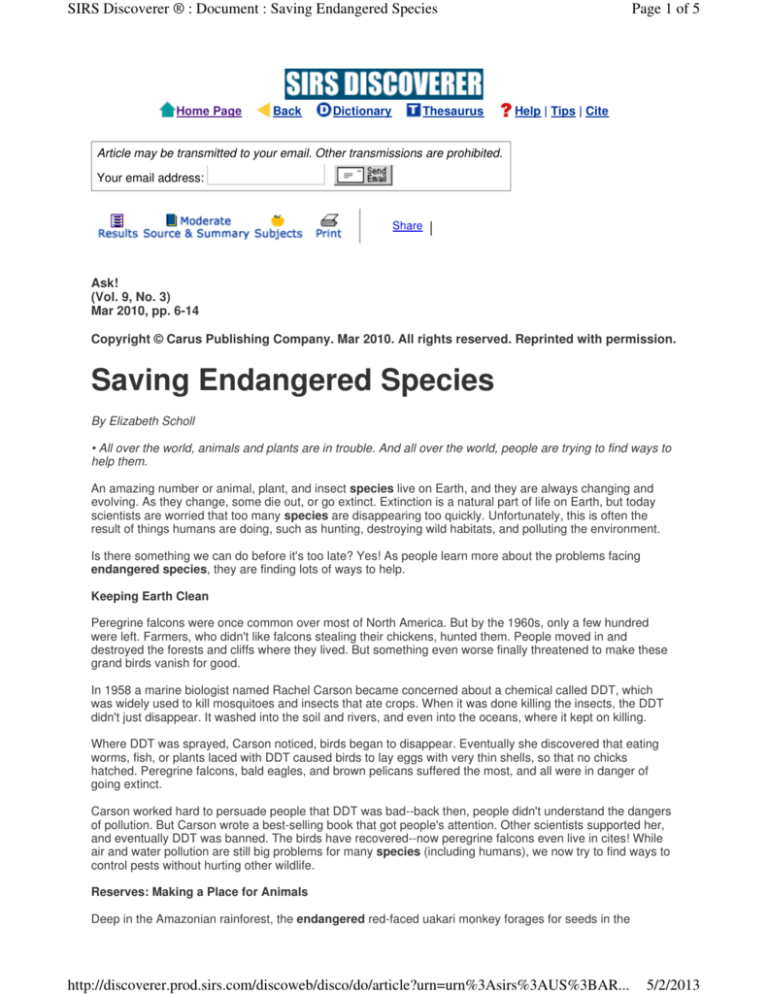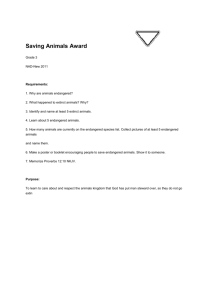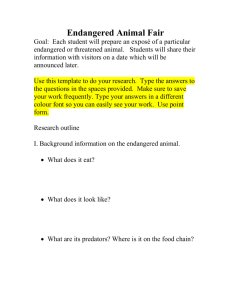
SIRS Discoverer ® : Document : Saving Endangered Species
Home Page
Back
Dictionary
Thesaurus
Page 1 of 5
Help | Tips | Cite
Article may be transmitted to your email. Other transmissions are prohibited.
Your email address:
Share
Share
Share
Share
| Share
Ask!
(Vol. 9, No. 3)
Mar 2010, pp. 6-14
Copyright © Carus Publishing Company. Mar 2010. All rights reserved. Reprinted with permission.
Saving Endangered Species
By Elizabeth Scholl
• All over the world, animals and plants are in trouble. And all over the world, people are trying to find ways to
help them.
An amazing number or animal, plant, and insect species live on Earth, and they are always changing and
evolving. As they change, some die out, or go extinct. Extinction is a natural part of life on Earth, but today
scientists are worried that too many species are disappearing too quickly. Unfortunately, this is often the
result of things humans are doing, such as hunting, destroying wild habitats, and polluting the environment.
Is there something we can do before it's too late? Yes! As people learn more about the problems facing
endangered species, they are finding lots of ways to help.
Keeping Earth Clean
Peregrine falcons were once common over most of North America. But by the 1960s, only a few hundred
were left. Farmers, who didn't like falcons stealing their chickens, hunted them. People moved in and
destroyed the forests and cliffs where they lived. But something even worse finally threatened to make these
grand birds vanish for good.
In 1958 a marine biologist named Rachel Carson became concerned about a chemical called DDT, which
was widely used to kill mosquitoes and insects that ate crops. When it was done killing the insects, the DDT
didn't just disappear. It washed into the soil and rivers, and even into the oceans, where it kept on killing.
Where DDT was sprayed, Carson noticed, birds began to disappear. Eventually she discovered that eating
worms, fish, or plants laced with DDT caused birds to lay eggs with very thin shells, so that no chicks
hatched. Peregrine falcons, bald eagles, and brown pelicans suffered the most, and all were in danger of
going extinct.
Carson worked hard to persuade people that DDT was bad--back then, people didn't understand the dangers
of pollution. But Carson wrote a best-selling book that got people's attention. Other scientists supported her,
and eventually DDT was banned. The birds have recovered--now peregrine falcons even live in cites! While
air and water pollution are still big problems for many species (including humans), we now try to find ways to
control pests without hurting other wildlife.
Reserves: Making a Place for Animals
Deep in the Amazonian rainforest, the endangered red-faced uakari monkey forages for seeds in the
http://discoverer.prod.sirs.com/discoweb/disco/do/article?urn=urn%3Asirs%3AUS%3BAR...
5/2/2013
SIRS Discoverer ® : Document : Saving Endangered Species
Page 2 of 5
treetops, while pink Amazon river dolphins swim among the trees of the flooded forest, feasting on fish that
live in the floodwaters. Shy jaguars hunt for alligators and sloths.
This river is also home to the black caiman, a cousin of the alligator and the largest predator in the Amazon.
Not long ago, people nearly hunted caimans to extinction for their skins, which were used to make fancy
shoes and bags. Thousands were killed.
To help save the caimans and other endangered animals of the Amazon, the government of Brazil set aside
this part of the forest as a reserve. Reserves are special areas of land or ocean kept just for animals to live in.
The 2.7-million-acre Mamiraua Reserve is the largest in Brazil. Since it was established in 1990, the black
caiman has recovered and is no longer endangered. Many other endangered species also find a haven
here.
Humans are not allowed to hunt or harm any plant or animal in a reserve, making them one of the best ways
to help endangered species. Reserves also help many species at once--animals, plants, insects, even
microbes--including some that scientists have not even discovered yet.
Species that share a home often depend on each other for food, shelter, spreading seeds, and many other
things. A reserve that keeps their ecosystem intact is the best way to help them all survive.
Zoos to the Rescue
The coastal rainforest of South America was once a vast jungle, home to many animals, including a small
honey-colored monkey called the golden lion tamarin. Then logging, farming, and cattle ranching destroyed all
but a few small patches of the old forest. Many tamarins were captured and sold as pets. By the 1980s, they
were on the brink of extinction.
Alerted to the danger, zoos around the world started a program to breed golden lion tamarins in captivity,
while naturalists in Brazil set up a reserve to save their habitat. Together they worked hard to bring tamarins
back to the rainforest.
Tamarins could be bred in zoos, but the zoo-born tamarins needed to be taught how to live in the wild.
Scientists at the National Zoo in Washington, D.C., first allowed the tamarins to roam freely in a small wooded
area at the zoo. This let the tamarins get used to real trees and big spaces outside a cage. Zookeepers hid
food in tubes and tied them to trees to teach the monkeys to forage.
When they were ready, families of zoo-bred tamarins were flown to Brazil and released into the forest.
Watchers were nearby to lend a hand or provide food and shelter while they got used to their new home.
The program has been a great success. Today there are enough tamarins in the wild that they are no longer
critically endangered. Now scientists are working to enlarge the reserve and make corridors so the animals
can roam over a wider area.
Modern zoos are much more than just animals in cages. They work hard to help endangered species and
teach people care for animals everywhere.
Trees Please!
Kenya's Mara River flows through the Masai Mara Reserve, watering the grasslands that provide food for the
wildebeests, lions, cheetahs, rhinoceroses, elephants, giraffes, hippos, and zebras that live there. Kenya is
also home to about 40 million people. And they all need water. The Mara brings water to farms and towns too.
But this year the river is dangerously low. Where has all the water gone?
The answer lies far upriver, where the Mara starts, in Kenya's Mau Forest. There, millions of leaves channel
rainwater into streams.
Tree roots hold the soil in place, keeping mud out of the river. The forest is home to many rare animals and
birds. But in recent years times have been hard, and people have cut down many trees for firewood or to
clear land for farms. Without trees, the streams and rivers clog with mud and dry up. And without water,
people and animals all suffer. Wangari Maathai is a Kenyan activist who has worked for many years to
encourage the people of Africa to plant more trees. She runs a program called Green Belt, which helps
ordinary African women plant trees in their communities. It started as a way to make life a little better for the
women, who often had to walk long distances to gather firewood.
http://discoverer.prod.sirs.com/discoweb/disco/do/article?urn=urn%3Asirs%3AUS%3BAR...
5/2/2013
SIRS Discoverer ® : Document : Saving Endangered Species
Page 3 of 5
But planting trees does much more. Tree roots keep dirt from blowing or washing away. This makes richer
farms and cleaner water, and keeps the rivers flowing. Trees also give fruit, which people can eat or sell to
make a little money. Trees clean the air and provide habitat for many birds and animals. With more trees, life
is better for everyone. And a tree is easy to plant.
Since it started in 1977, the Green Belt movement has spread to 20 countries and planted more than 40
million trees. In 2004 Wangari Maathai won the Nobel Peace Prize for her work to help her people and the
planet.
Trees are good for the women of Africa, good for wildlife, and most of all, good for the future. In fact, taking
action to help endangered species often turns out to help people too. After all, we share the same Earth!
Invasive Species: Keep Out!
The cane toad, native to South America, was brought to Australia to try to control beetles that were nibbling
sugar-cane crops. Unfortunately, the cane toads didn't eat the beetles, but they do eat almost everything else-insects, birds' eggs, mice, and even native lizards and frogs.
Cane toads have poison skin, so not even crocodiles will eat them. The toads grow as big as dinner plates,
and they reproduce quickly. There are now about 200 million cane toads in Australia (10 for every person!),
and many native frogs, birds, and lizards are endangered or have disappeared--eaten, poisoned, or crowded
out by the cane toads. If Australia's wildlife is to survive, the toads have to go.
Australians have been trying to get rid of the cane toads for 50 years, and they are still looking for a good
solution. Cane toads seem to be immune to the chytrid fungus that is killing other amphibians. Recently
scientists have found a native ant that eats young toads--maybe ants will be the answer.
Invasive species like the cane toad, cats, rats, carp, beetles, and tree snakes (to name just a few) are a big
problem for endangered species everywhere. Whether they hitch rides on ships or planes, or are set loose
by people on purpose, without natural predators, invaders can throw a whole ecosystem out of balance. And
they are often hard to get rid of. Learning a lesson from the hungry cane toad, people now take strong steps
to keep invaders out.
Save a Habitat
You can make a reserve in your very own yard. Plant some native plants in your garden, that insects, birds,
and animals in your area like. Native plants are those that grew there before people brought plants from other
places. These should be easy to grow, because they are suited to the climate. And they will not be invasive or
grow out of control.
If you live in an area with bats or owls, you can help them by building a bat box or nesting post so they have
somewhere to live. Or leave an old dead tree standing (if it is safe to do so) instead of cutting it down. Old
trees and logs make good homes for all kinds of animals.
Cloning: A Good Idea?
Inside every cell of every living thing is a special code called DNA, which carries all the information about the
organism. It is possible (though difficult) to grow a new identical animal by using the DNA from a single cell.
This is called cloning.
Could we use cloning to save endangered species? Maybe, as a last resort. Some zoos are storing DNA
samples from endangered species, just in case. While a few endangered animals have been cloned,
including a gray wolf and a type of ox called a gaur, the clones were not healthy animals. Scientists still have
a lot to learn about the process.
Could we use cloning to bring back extinct animals, such as the mammoth? If we did, who would raise it,
without any other mammoths around? Would it be happy all alone? Cloning raises lots of questions.
***
http://discoverer.prod.sirs.com/discoweb/disco/do/article?urn=urn%3Asirs%3AUS%3BAR...
5/2/2013
SIRS Discoverer ® : Document : Saving Endangered Species
Page 4 of 5
What is an endangered species? When there are so few of an animal left that the species is in danger of
going extinct, we say that they are endangered. Here are just a few of Earth's rarest inhabitants.
Giant panda: China
Prairie fringed orchid: North America
Pinta Island tortoise: Galapagos Islands
Blue whale: All oceans
Harlequin frog: South American rainforests
Sea otter: North America
Tiger: India, Asia
Black rhinoceros: Central Africa
Blue-throated macaw: Bolivia
American burying beetle: North America
Elkhorn coral: Tropical oceans
Polar bear: Arctic
Northern hairy-nosed wombat: Australia
Hawksbill sea turtle: Tropical oceans
Gharial (river crocodile): India
California condor: North America
Black stilt: New Zealand
Saola: Vietnam
Sawfish: Tropical oceans
European eel: Europe
Sumatran orangutan: Sumatra
Blue iguana: Grand Cayman
Oahu tree snail: Hawaii
Kakapo: New Zealand
Hawaiian monk seal: Hawaii
Ethiopian wolf: Ethiopia
Visayan warty pig: Philippines
Nene: Hawaii
Orinoco crocodile: Colombia and Venezuela
Florida panther: Florida
Chinese giant salamander: China
Pygmy hippopotamus: Liberia
Philippine eagle: Philippines
Western lowland gorilla: Africa
Scientists estimate that more than 17,000 animals and plants around the world are currently under threat from
various causes. Humans can do a lot to harm or help them. Which will it be?
Citation :
You can copy and paste this information into your own documents.
Scholl, Elizabeth. "Saving Endangered Species." Ask! (Vol. 9, No. 3). Mar 2010: 6-14. SIRS
Discoverer. Web. 02 May 2013.
Home Page | Current Events | Spotlight of the Month | World Almanac | Encyclopedia
Dictionary | Thesaurus | Help | Tips | Cite | Workbooks | Tutorial | Research Topics
Educator Resources | Privacy | Accessibility | License | Contact
Copyright © 2013 ProQuest LLC. All rights reserved.
http://discoverer.prod.sirs.com/discoweb/disco/do/article?urn=urn%3Asirs%3AUS%3BAR...
5/2/2013
SIRS Discoverer ® : Document : Saving Endangered Species
http://discoverer.prod.sirs.com/discoweb/disco/do/article?urn=urn%3Asirs%3AUS%3BAR...
Page 5 of 5
5/2/2013







